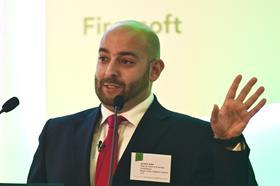It is finally here! You have all waited so patiently, but I am delighted to confirm that the Legal Sector Affinity Group’s (LSAG) revised and much updated anti-money laundering (AML) guidance has, after much anticipation, finally landed. The good news is the Law Society can help making getting through it all easier, but more on that at the end.

The review of the guidance was triggered by the European Union’s fifth money laundering directive, which came into force in January last year and brought in a raft of new requirements including changes to client due diligence and enhanced due diligence as well as a duty to collect proof of registration for companies and trusts.
The directive provided an opportunity to review and update the current guidance, which has been extensively revised and redrafted before being launched this week. The revised guidance has been developed by the 12 LSAG members including the Law Societies of England and Wales, Scotland and Ireland, SRA, Bar Council, CILEX and the Bar Standards Board, which represent the UK’s legal sector’s supervisors and regulators.
As you can imagine creating a single piece of guidance that meets the needs of all members of the UK’s diverse legal sector has been a real challenge requiring compromise and creativity on all sides.
Where possible the MLTF has sought to ensure regulatory expectations and burdens were tempered by practical reality. Balancing the many demands that practitioners are under while recognising the importance of our role in the fight against financial crime and the need for a minority to up their game.
The guidance is an effective and critical tool in supporting the profession. It is designed to help the legal profession navigate complex AML risks and challenges. It will guide you through what is a ‘must’, a ‘should’ and a ‘may’ to help ensure practices are able to understand and address AML risk to meet regulatory requirements, SRA expectations and identify good practice.
Of particular interest is a revised Legal Professional Privilege (LPP) section, an updated training section, a fully revised and expanded risk assessment section and the introduction of key AML compliance principles.
There is also additional advice on understanding and evidencing source of funds and wealth, a new technology section, which examines considerations to apply when using or exploring AML-related technology to effectively mitigate risk and revised, updated and expanded AML governance and internal controls sections.
In many ways this iteration of the guidance is a complete re-write and covers several new areas and changes members must be aware of. It is a lot to wade through. As promised, the good news is, to support the profession further, the Law Society will be hosting a series of webinars on the updated guidance.
These will break up the key sections and changes and talk through the most relevant parts of the updated guidance. This is a chance to hear from the MLTF and the SRA, who together have helped guide much of the development and drafting over the past year.
Amasis Saba is head of business acceptance (UK, CE & MENA) at Freshfields Bruckhaus Deringer and chair of the Law Society’s Money Laundering Task Force

















![David Lester (senior partner at Blythe Liggins), Darryl Barnes, Jagdeep Sandher (head of dispute resolution at Blythe Liggins)[4]](https://d1d8vslyhr7rdg.cloudfront.net/Pictures/274x183/4/2/8/116428_davidlesterseniorpartneratblytheligginsdarrylbarnesjagdeepsandherheadofdisputeresolutionatblytheliggins4_981603_crop.jpg)









2 Readers' comments